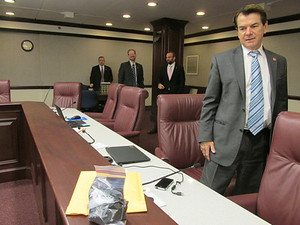
Sen. Thad Altman, R-Melbourne, looks at a bag of muck from Indian River Lagoon given to senators on Wednesday during a meeting of the Committee on Environmental Preservation and Conservation. Photo by Bruce Ritchie.
A university scientist on Wednesday wanted to do more than just tell senators about the black muck wreaking environmental havoc in the Indian River Lagoon.
He wanted each of them to have some of the stuff, which he described as "black mayonnaise."
John H. Trefry, a professor of marine and environmental sciences at the Florida Institute of Technology, told the Senate Committee on Environmental Preservation and Conservation that 5 million to 7 million cubic yards of the muck covers portions of the lagoon bottom and has helped kill 47,000 acres of sea grass.
He gave each of the senators on the committee a quart bag of the muck inside packing envelopes -- with a warning.
"Please don't open the bag that's in the inside," he said. "We will all be leaving the room very quickly. The smell of hydrogen sulfide will be quite strong."
He said muck that could be removed from the lagoon would fill 6 billion of the quart-sized bags.
The Senate last summer focused on the woes of Indian River Lagoon amid the death of hundreds of manatees, dolphins and pelicans from unknown causes.
The Select Committee on Indian River Lagoon and the Lake Okeechobee Basin in November approved a 23-page report with recommendations that would cost the state $160 million in fiscal year 2014-15. Those recommendations include $20 million per year for muck removal.
Trefry said the muck accumulated over the past 60 years from stormwater and fertilizer runoff, leaky septic tanks, erosion and other sources.
The muck continues to release nutrients into the water, feeding algal blooms, and shading and killing sea grasses, Trefry said. Since the 1980s, he said, there has been an "incredible" expansion of the area covered by muck, aided by hurricanes Frances and Jean in 2004.
Muck removal could take five to seven years, he said, but he said a study to pinpoint the cost and duration of the work is being done by the Florida Inland Navigation District, a special state taxing district that maintains the Atlantic Intracoastal Waterway.
Trefry said there is reason for optimism that the lagoon's problems can be reversed as the muck is removed.
Sen. Thad Altman, R-Melbourne, said the deaths of manatees, dolphins and pelicans were "mind boggling."
"I think it's the canary in the coal mine," he said. "I think it's a bigger issue affecting our state as a whole."
Sen. Charlie Dean, R-Inverness and chairman of the Senate Committee on Environmental Preservation and Conservation, agreed that muck is a problem for other water bodies, pointing to a restoration project 10 years ago on Lake Panasoffkee in Sumter County.
State economists say the state could have a budget surplus in excess of $1 billion in fiscal year 2014-15. Dean indicated that more spending for environmental programs, such as muck removal, could come from that budget surplus.
"This will come from the growth money," he said.
Related Research:
* Nov. 8, 2013 Report of the Senate Select Committee on Lake Okeechobee and Indian River Lagoon Basin
* Dec. 11, 2013 Presentation by John H. Trefry to Senate Committee on Environmental Preservation and Conservation
Reporter Bruce Ritchie can be reached at [email protected].

